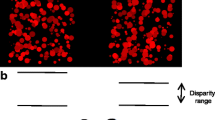Abstract
Natural stereopsis is better with a large interpupillary distance (IPD). With haploscopic devices, depth perception is better with a small IPD. This apparently unknown fact has been trigonometrically calculated and experimentally shown by enlarging and diminishing the IPD in 20 subjects.
Similar content being viewed by others
References
Frisby Stereotest: Manufacturer's instructions. Clement Clarke, International Ltd, London
Hofmann FB (1970) Die Lehre vom Raumsinn des Auges. Springer, Berlin Heidelberg New York (reprint from Graefe-Sämisch)
Lang J (1982) Zur Prüfung des Stereosehens am Polatest. In: Augenärztliche Fortbildung, Band 7, Teil 3. Urban und Schwarzenberg, München, pp 356–359
Lang J (1983) A new Stereotest. J Pediatr Ophthalmol Strabismus 20:21–23
Lang J (1984) The two-pencil test and the new Lang Stereotest. Br Orthopt J 41:15–21
Author information
Authors and Affiliations
Rights and permissions
About this article
Cite this article
Lang, J., Rechichi, C. & Stürmer, J. Natural versus haploscopic stereopsis. Graefe's Arch Clin Exp Ophthalmol 229, 115–118 (1991). https://doi.org/10.1007/BF00170541
Received:
Accepted:
Published:
Issue Date:
DOI: https://doi.org/10.1007/BF00170541




